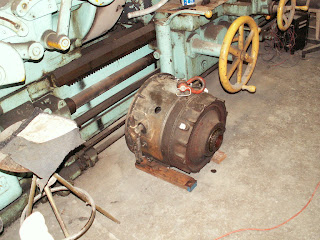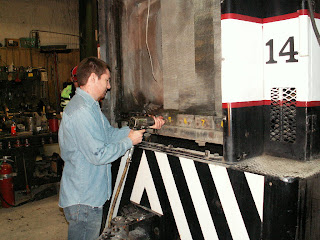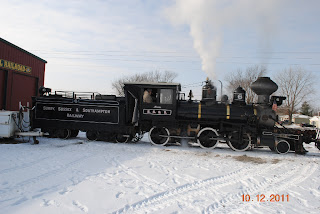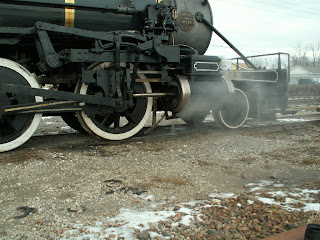Expecting it to be cold (isn't that a surprise for late November and December!) we decided to enclose the rear of the 6's cab. This was not a problem in past years because, with a few exceptions in 2010, the 6 never performed for North Pole Express. The 9's cab was nearly enclosed except for the entryway to the tender and that had a curtain.
On Thanksgiving Day, while everyone else was chomping on turkey, volunteer Elliot H. was converting some moving blankets into a cab enclosure. The 40 inch wide panels were perfect for the enclosure. One panel for each side and two across the back offered sufficient overlap.
Although there are no pictures to offer proof, on Thanksgiving Friday, Elsie B., Brian B., Jesse V. and Elliot H. finished the curtain project and readied the 6 for service. They filled the boiler at the special "water station" provided by the city of Mount Pleasant, performed (another) mid-season hydro test and then brought the boiler to pressure.
There was one day of North Pole Express trains for the first weekend, Saturday, November 26. This was the first time we operated on Thanksgiving weekend and as expected, everything worked well.
Much like the inaugural weekend, the second weekend went without a hitch. The 6 pulled every train on schedule.
There were plenty of opportunities for student firemen and student engineers to get time operating the 6.
After 4 days of flawless operations we were lulled into complacency: what could possibly go wrong?
Well, it became cold.
The Thanksgiving weekend and first weekend of December were unseasonably warm. Having the cab curtains was still a necessity --
it wasn't that warm! -- but every day was above freezing, and on some days, well above freezing.
The cab crew lit the fire early on December 10, Saturday morning. Notice the snow? The temperature was hovering right around zero that morning. The snow was "crunchy."
The fun thing about zero F was that the steam was really thick. Not any thicker than on any other day, but the extreme cold enhanced the appearance of the steam.
The cab crew gave a quick test of the boiler blowdown valve.
The engineer slowly moves the 6 away from the shop. With the cylinder cocks open, the front of the 6 begins to disappear from sight.
We like to take a few laps to warm the steam cylinders. Here, the 6 running light climbs the hill into the north station.
With the cylinder cocks open and working hard, the 6 puts on quite a show.
So...what about the cold? While we were bringing the boiler to pressure and making the light laps, the fuel in the tender was getting colder and colder. With the engine idling or running light everything appeared normal -- and then we put cars on it.
It was noticed pulling up the hill with empties that there just wasn't enough fire to keep the pressure up. Then, 200 passengers boarded the train -- and we suspected there wouldn't be enough heat to pull it around the loop. That cold oil was cold THICK oil and simply wouldn't flow through the fuel line fast enough to provide the necessary fire.
While the first train's passengers were loading, another crew warmed the diesel Plymouth switcher, the 14, and met us along the east side of the park. We coupled up and let the 14 do most of the work. All we needed to do was run the air compressor for the train brakes but not much more.
While all of this was happening, we made a special order of diesel fuel to dilute the "tar" in the tender. As soon as we uncoupled from the first train, we moved the 6 to the yard to await the diesel shipment. We unloaded about half the thick oil in the tender and added 200 gallons of diesel fuel.
Unfortunately, we missed pulling the first train out of the south station and pulling the second train of the day. However, once the diesel was thoroughly mixed with the heavy oil, the 6 performed like it did on the warm days.
Following the six days of North Pole Express, Roger R, Steve R., Chris P., and Elliot H did the end of season boiler wash. The previous washes (after the Old Threshers' Reunion and Ghost Train) were quick boiler rinses. The end of season wash requires removal of all boiler plugs and check valves, removing all of the residual water from the steam lines, and an extensive washing of the boiler.
We accomplish the removal of residual water by pressurizing the boiler with the twin-screw gasoline air compressor. If you look closely, you can see the hose leading from the compressor to the rear of the cab.
Steve R. holds the air hoses as Roger R. runs the engine back and forth to force the water out.
The mist coming from the right hand steam cylinder is being forced out by the compressed air flowing through the lines.
After going back and forth numerous times, it was almost time to move the engine into the shop to remove the boiler's plugs.
One of the plugs (actually, not a plug but a "hand hold") is located in the smoke box, which gets incredibly dirty after 6 days of operation. Using a pressure washer, Elliot H. washes the soot out of the smoke box so the hand hold can be a) located and b) removed.
Not shown was backing the locomotive into the shop with compressed air, or the removal of the plugs.
With the plugs out, it was now time to wash the boiler.
We moved the 6 to the "washing station" and started the most critical part of the entire project.We consider it the most critical because every last bit of "crud" must be removed from every nook and cranny inside the boiler.
Steve R. is suited up with rain gear (lots of water splashes back on the operator) and readies himself for the first phase. Chris P. untangles the water line.
Roger R. guards the golf cart -- and stands watch for Steve's indication to "stop the water!"
After washing the boiler (and with the pressure washer, washing the top of the tender and cab) we moved the 6 back into the shop to install several small blowers to help dry the boiler.
-steam.airman






































